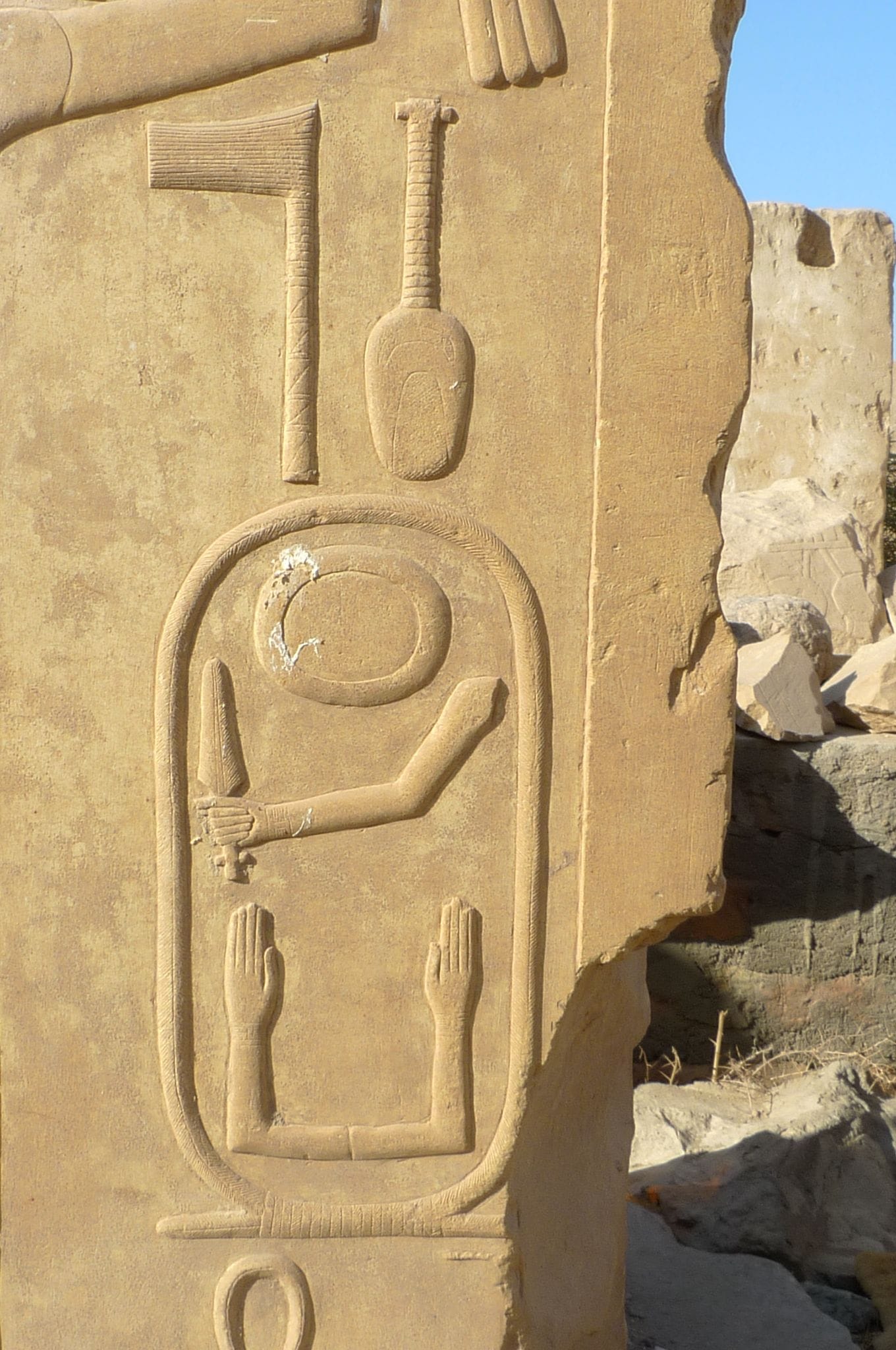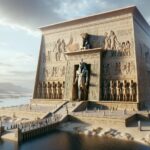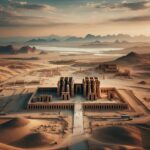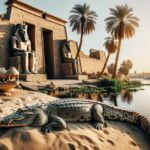Decoding Djoser’s Cartouche: Symbolism, Power, and Legacy
Step into the fascinating world of ancient Egypt and embark on a journey through the reign of Djoser, a pharaoh whose cartouche offers us a glimpse into the power and symbolism of the Third Dynasty. Like a royal signature, the cartouche unveils the secrets of Djoser’s rule, representing both his divine authority and the sacred link between pharaohs and the celestial realm. By deciphering the hieroglyphs within Djoser’s cartouche, we unlock the meaning of his Horus name “Netjerikhet,” an epithet signifying “Divine of Body” that emphasizes his status as a god-king chosen by higher powers to lead Egypt.
The Cartouche: More Than Just a Name
In ancient Egypt, a cartouche was more than a simple nameplate for royalty; it was a symbol brimming with meaning and power. Imagine the weight of a pharaoh’s name, their official title, imbued with the authority of their position. Enclosing it within the oval shape of a cartouche, like placing it in a protective bubble, elevated it, made it sacred. The cartouche itself became a symbol of the pharaoh’s supreme power, their divine right to rule, granted by the gods themselves. It was a visual declaration stating, “This person is in charge, and their authority comes from on high.”
This connection to the divine was paramount. The cartouche wasn’t just about earthly power; it linked the pharaohs directly to the gods. It reinforced their special status as divine intermediaries, the bridge between the human and celestial realms. Imagine it as a symbol of their divine mandate to rule, a constant reminder of their sacred duty.
But the significance of the cartouche extended beyond its symbolism. The ancient Egyptians believed it offered genuine magical protection. By enclosing the pharaoh’s name, it was thought to shield it – and the pharaoh themselves – from harm, from evil spirits and negative forces. It was akin to a magical ward, safeguarding the ruler’s very essence. This belief in its protective power likely contributed to its widespread use and enduring importance.
The cartouche also played a role in the greater understanding of the Egyptian worldview. Ma’at, the concept of cosmic order, balance, and harmony, was central to Egyptian belief. The pharaoh was responsible for upholding Ma’at, and the cartouche subtly symbolized this immense responsibility. It served as a visual reminder of their role in maintaining the delicate balance of the universe.
While much is understood about the cartouche, there is always more to uncover. Ongoing research continues to shed light on its various interpretations and significance. Some scholars suggest it may have also symbolized the cyclical nature of life and rebirth, connecting the pharaohs to the eternal cycle of the cosmos. Others believe it might have even represented the sun’s journey across the sky, further linking the pharaoh to the powerful forces of nature.
Our understanding of ancient Egyptian symbolism is constantly evolving. While we can confidently say the cartouche represented royal power, divine connection, and magical protection, there might be nuanced layers of meaning we are still unraveling. This ongoing exploration is part of what makes studying ancient Egypt so captivating. The cartouche, a seemingly simple oval, reveals a complex web of beliefs and practices, offering a glimpse into the minds of a civilization that thrived thousands of years ago.
The Enduring Legacy of Djoser
Djoser, a pharaoh from ancient Egypt’s Third Dynasty, is a figure somewhat shrouded in mystery, yet his impact on Egyptian history is undeniable. He was a pivotal figure during a time of incredible advancements in architecture, art, and religious practices. Djoser was a trendsetter, someone who significantly impacted the trajectory of ancient Egyptian civilization.
Djoser is perhaps best known for the Step Pyramid at Saqqara. This wasn’t merely another pyramid; it was the world’s first monumental stone structure. Before Djoser, large-scale buildings were typically made from mud-brick. He completely changed the game, constructing something so grand and lasting in stone. This architectural wonder wasn’t just impressive in its size and materials; its very shape was innovative, a stepped design that was unlike anything that had come before. The Step Pyramid stands as a testament to Djoser’s ambition and vision, as well as the skill of his architect, Imhotep, who some scholars suggest might have been deified later for his genius.
This pyramid wasn’t just a tomb; it was a massive complex designed to facilitate Djoser’s transition into the afterlife. It was adorned with intricate reliefs and stunning sculptures, many of which depicted scenes from Djoser’s life and reign. These artworks offer us a glimpse into the daily life, beliefs, and rituals of ancient Egyptians, acting like snapshots from the past to help us better understand a culture that existed thousands of years ago. We can learn a great deal about their worldview, their gods, and even their sense of humor through these artistic treasures.
The construction of the Step Pyramid likely involved an incredible amount of resources and manpower, further demonstrating Djoser’s power and influence. While we can’t know for sure exactly how it was built, ongoing research suggests various theories about the logistics and engineering techniques involved. We are still learning and making new discoveries all the time, and there is ongoing debate, for example, about the specific stages of construction and how the design evolved over time. Some experts believe that the pyramid’s stepped form might have symbolized a stairway to heaven, while others suggest it may have represented a primeval mound associated with creation myths. These are just some of the fascinating questions archaeologists are still exploring.
Our understanding of Djoser and his time is constantly evolving as new archaeological evidence comes to light. What we know is based on interpretations of artifacts and historical texts, and there’s always the potential for new discoveries to reshape our understanding.
Beyond the Step Pyramid, Djoser’s reign may have been a period of relative peace and prosperity, although the details remain somewhat unclear. His legacy extends beyond architecture; it’s about innovation, artistic expression, and the enduring power of ancient civilizations. He laid the foundation for the great pyramid builders who followed, setting the stage for the iconic structures that define our image of ancient Egypt. So, while many aspects of Djoser’s life and reign remain shrouded in the mists of time, one thing is clear: He left an indelible mark on history.
What’s in a Name? The Meaning of Djoser
Let’s delve deeper into the name of this fascinating pharaoh. We know him as Djoser, but he wasn’t always called that. His original name, the one he was likely known by in his early life, was Netjerikhet. This name, though a mouthful for us today, is packed with meaning, translating roughly to “divine of body.” This tells us right away that even from birth, he was seen as someone special, someone connected to the gods. This idea of the pharaoh as a divine being was a cornerstone of ancient Egyptian belief, and it’s reflected right there in his very first name.
So, how did Netjerikhet become Djoser? It is a linguistic journey across millennia. Think of it like how names can change or get shortened over time – “Robert” becomes “Bob,” “Elizabeth” becomes “Liz.” Over the centuries, “Netjerikhet” evolved, morphing into different forms like “Djeser” and, eventually, the name we’re most familiar with: “Djoser.” These are all basically different ways of transliterating the original Egyptian hieroglyphs into sounds we can pronounce today, like different accents for a name across different regions or time periods.
This transformation wasn’t random. Names held immense power in ancient Egypt. They weren’t just labels; they were believed to be part of a person’s essence. So, the shift from Netjerikhet to Djoser likely happened gradually, perhaps influenced by how people spoke the name or by changes in the Egyptian language itself. Researchers are still unraveling all the details, and it’s an area of ongoing study.
While “divine of body” is the generally accepted meaning of Netjerikhet, some scholars offer slightly different interpretations. Some suggest the meaning might be closer to “holy body” or even “body of the god.” These subtle differences might seem minor, but they can lead to different understandings of how the ancient Egyptians viewed their pharaohs and the relationship between the divine and the human.
This element of uncertainty is common when studying ancient history. We’re piecing together a puzzle with some missing pieces, relying on interpretations of texts, artifacts, and other clues. What we know today about Djoser’s name, and indeed about ancient Egypt as a whole, is constantly being refined as new discoveries are made and new theories emerge. So, while we may not have all the answers right now, ongoing research continues to paint a richer and more nuanced picture of this intriguing period in history.
This whole discussion about Djoser’s name might seem like a minor detail, but it speaks volumes about his reign and the beliefs of his time. It underscores the close connection between the pharaoh and the divine, a concept that shaped Egyptian society and culture for centuries. It also highlights the complexities and challenges of understanding the past, reminding us that history is a continually evolving narrative.
Djoser’s Cartouche: A Window into the Past
Djoser’s reign, marked by his distinctive cartouche and the groundbreaking Step Pyramid, represents a pivotal era in ancient Egyptian civilization. The evolution of his name, from Netjerikhet to Djoser, reflects the fluidity of language and the enduring power of ancient traditions. His legacy extends far beyond the imposing stones of Saqqara, serving as a testament to the enduring human spirit of innovation, creativity, and the quest to transcend mortality. As we continue to uncover the secrets of Djoser’s reign, we gain a deeper understanding not only of ancient Egypt but also of our own place within the grand tapestry of history.
Delve into the enigmatic history of the Teutonic Knights Templar gauntlet from the year 1200, an exquisitely crafted artifact that whispers tales of battles, crusades, and the indomitable spirit of medieval warriors.
- Revolution Space: Disruptive Ion Propulsion Transforming Satellites - April 24, 2025
- Race Through Space: Fun Family Game for Kids - April 24, 2025
- Unlocking the Universe: reading about stars 6th grade Guide - April 24, 2025
















